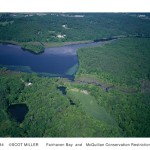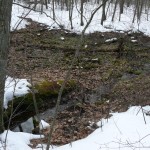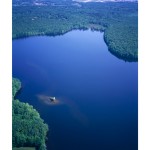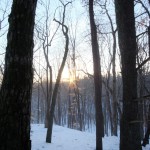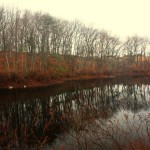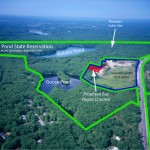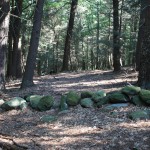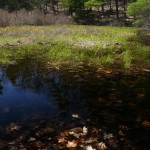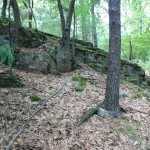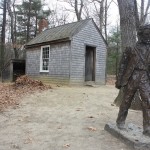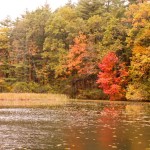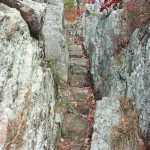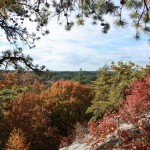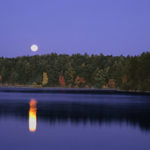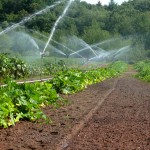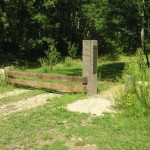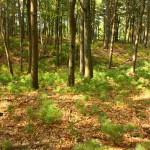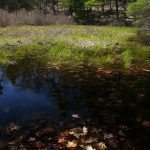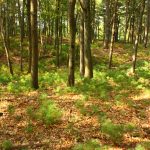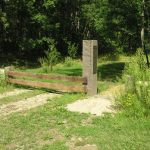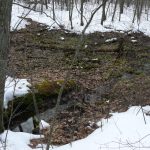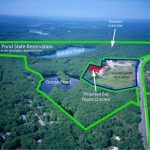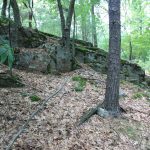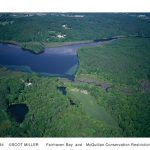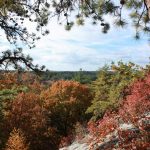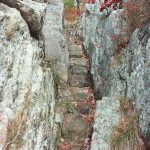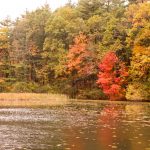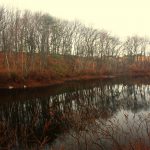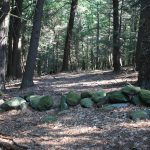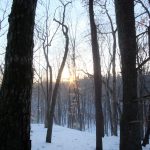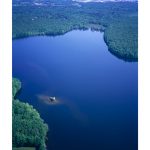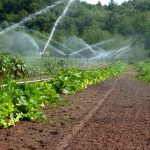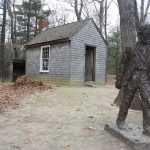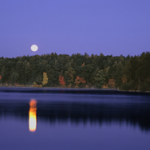Walden Pond and the surrounding ecosystem inspired Thoreau, and his writing led to the modern conservation movement and environmental stewardship ethic.
Explore some of the interesting natural features that Thoreau knew and loved, and learn what The Walden Woods Project has accomplished in protecting Walden Woods for future generations.
Fairhaven Bay
About Like Walden Pond, Fairhaven Bay was created by a large block of glacial ice. Glaciers eroded the land and left a depression that was filled with melted glacial ice. Consequently, Fairhaven Bay looks like a lake and is situated within the Sudbury River channel in Concord. Woods Burner On April 30, 1844, Thoreau was
Learn more ...
Brister’s Spring
About Brister’s Spring is one of two springs believed to be fed by Walden Pond. It feeds nearby Fairyland Pond in Concord’s Hapgood-Wright Town Forest. The spring lies along the Bay Circuit Trail and the town’s Emerson-Thoreau Amble. History Brister’s Spring is named after Brister Freeman, once a slave in Concord and the second person
Learn more ...
Sandy Pond
About Sandy Pond, also known as Flint’s Pond, is the primary water supply for the Town of Lincoln. This was the site of Thoreau’s first sojourn to the woods around 1837 where Thoreau lived in a cabin with his Harvard classmate Charles Stearns Wheeler. After Thoreau’s short stay at Sandy Pond, he frequently came back
Learn more ...
Pine Hill
About Pine Hill is a large tract of land near the Thoreau Institute at Walden Woods. Much of it is preserved by the Town of Lincoln and Lincoln Land Conservation Trust for passive recreation. It was one of Thoreau’s favorite huckleberry picking spots. This drumlin overlooks Wachusett and Mt. Monadnock. Preservation Pine Hill is largely
Learn more ...
Goose Pond
About Goose Pond is a beautiful kettle pond that is a part of the Walden Pond State Reservation. The property around Goose Pond can be explored on a trail from the parking lot. Goose Pond is the subject of some of Thoreau’s writings and was a milestone for Thoreau when he traveled to Lincoln. Thoreau
Learn more ...
Concord Landfill
About The Concord Landfill opened in 1959 with little opposition, drastically changing the landscape of Walden Woods. The landfill was placed where The Cold Hollows and Little Goose Pond used to sit. Excess nutrients from the landfill have in the past caused eutrophication in surrounding bodies of water including Walden Pond. In 1994 the landfill
Learn more ...
Mount Misery
About At the south-westernmost point of Walden Woods exists Mount Misery. This was a place Thoreau visited occasionally, where he paid much attention to the regeneration of forest trees. To the west of Mount Misery is the Sudbury River while Beaver Dam Brook runs through the conservation land. Mount Misery is also home to features
Learn more ...
Andromeda Ponds
About: The Andromeda Ponds are a beautiful string of three glacial kettle ponds fed by groundwater originating in Walden Pond. These ponds afford rich wildlife habitat surrounded by Adams Woods, conservation land in Concord, MA. The Andromeda Ponds were the subject of some of Thoreau’s journal entries. Andromeda Phenomenon: On some sunny days, the Andromeda
Learn more ...
Emerson’s Cliff
About By the Pond Path and in the heart of Walden Woods exists Emerson’s Cliff. Emerson’s Cliff overlooks Walden Pond from the south. Named by Thoreau, this peak was once considered by Ralph Waldo Emerson as a site for his own sylvan retreat. Preservation The Massachusetts Department of Conservation and Recreation maintains and preserves Emerson’s
Learn more ...
Thoreau’s Cabin Site
About The location of Thoreau’s cabin was discovered by archaeologist Roland Robbins in 1945, nearly 100 years after Thoreau left Walden Pond. In addition to the discovery of the original hearth stone, a number of artifacts from Thoreau’s stay were found, many of which are housed at The Walden Woods Project Library. Preservation While Thoreau’s
Learn more ...
Fairhaven Bay CR
About Across the Sudbury River from Fairhaven Hill is a large track of land preserved along the edges of Fairhaven Bay. Since 2001, The Walden Woods Project has held a conservation restriction on this parcel. Preservation When the conservation restriction was placed, it was specified that a bulk portion of the land should be kept
Learn more ...
Fairyland Pond
About A beautiful, impounded pond, today it is a favorite destination for local school groups on biology and history expeditions, as it was for many of Thoreau’s own outings with school children. Fairyland Pond is located on Concord Town Forest land. Fairyland Pond is awash with wildlife and is of paramount importance in maintaining the
Learn more ...
Fairhaven Hill
About Near Bear Garden Hill and the Boiling Spring, the beautiful Fairhaven Hill was one of Thoreau’s favorite destinations and is often referred to in his writings. Thoreau would often travel to Fairhaven Hill to pick huckleberry. Preservation Fairhaven Hill is only partially preserved. The Concord Land Conservation Trust preserves Seton Woods at the base
Learn more ...
Fairhaven Cliffs
About Fairhaven Cliffs are a unique natural feature overlooking Fairhaven Bay and points West towards Mount Wachusett. These cliffs were frequented by Thoreau and used as a vantage point over Fairhaven Bay. Access The Fairhaven Cliffs are on private property and cannot be directly accessed. Recreation While the Fairhaven Cliffs cannot be directly accessed, there
Learn more ...
Walden Pond
About Walden Pond is the centerpiece of Thoreau’s Walden Woods and is the focus of Thoreau’s most famous piece: Walden. It is owned and managed by the Massachusetts Department of Conservation and Recreation, and sees nearly 600,000 visitors every year. An exceptionally deep and remarkably clear kettle lake, Walden still inspires the conservation ethic that
Learn more ...
The Walden Woods Project
About The Walden Woods Project’s headquarters is a center for research and education focusing on Thoreau’s literary achievements, philosophy and his influence on the environmental and social movements of the 20th and 21st centuries. The campus comprises three primary structures situated on twenty-two acres of conservation land in the heart of Walden Woods. The largest
Learn more ...
The Walden Woods Project Farm
About The Walden Woods Project Farm is a USDA certified organic vegetable farm. Through growing and selling a range of produce like squash, eggplant, pumpkins, tomatoes and corn, The Walden Woods Project is able to use all proceeds to directly support The Walden Woods Project Farm and also fund the Project’s efforts to protect more
Learn more ...
The Boiling Spring
About The Boiling Spring at Bear Garden Hill was Concord’s coldest and most popular spring from colonial days and a literary symbol for the Transcendentalists. It was so named because it bubbled as it oozed from the earth. Thoreau considered the Boiling Spring one of the wonders of Walden Woods. “There are few really cold
Learn more ...
Brister’s Hill
About Brister’s Hill is a few hundred feet from Walden Pond, and was one of Henry David Thoreau’s study sites later in his life. In the late 1980s, a large commercial development was proposed on Brister’s Hill that was such a significant threat to the Walden ecosystem that the National Trust for Historic Preservation twice
Learn more ...
Bear Garden Hill
Located one half-mile west of Walden Pond, this forested tract that is part of the Fairhaven Hill area was one of Thoreau’s favorite places in Walden Woods. It was the first site protected by The Walden Woods Project, purchased from a developer in 1990. “My thoughts expand and flourish most on this barren hill, where in
Learn more ...
Parking for Walden Pond and surrounding conservation land and trails.
Areas shaded in green are conservation land.
About: The Andromeda Ponds are a beautiful string of three glacial kettle ponds fed by groundwater originating in Walden Pond. These ponds afford rich wildlife habitat surrounded by Adams Woods, conservation land in Concord, MA. The Andromeda Ponds were the … Read more
Located one half-mile west of Walden Pond, this forested tract that is part of the Fairhaven Hill area was one of Thoreau’s favorite places in Walden Woods. It was the first site protected by The Walden Woods Project, purchased from a … Read more
About Brister’s Hill is a few hundred feet from Walden Pond, and was one of Henry David Thoreau’s study sites later in his life. In the late 1980s, a large commercial development was proposed on Brister’s Hill that was such … Read more
About Brister’s Spring is one of two springs believed to be fed by Walden Pond. It feeds nearby Fairyland Pond in Concord’s Hapgood-Wright Town Forest. The spring lies along the Bay Circuit Trail and the town’s Emerson-Thoreau Amble. History Brister’s … Read more
About The Concord Landfill opened in 1959 with little opposition, drastically changing the landscape of Walden Woods. The landfill was placed where The Cold Hollows and Little Goose Pond used to sit. Excess nutrients from the landfill have in the … Read more
About By the Pond Path and in the heart of Walden Woods exists Emerson’s Cliff. Emerson’s Cliff overlooks Walden Pond from the south. Named by Thoreau, this peak was once considered by Ralph Waldo Emerson as a site for his … Read more
About Like Walden Pond, Fairhaven Bay was created by a large block of glacial ice. Glaciers eroded the land and left a depression that was filled with melted glacial ice. Consequently, Fairhaven Bay looks like a lake and is situated … Read more
About Across the Sudbury River from Fairhaven Hill is a large track of land preserved along the edges of Fairhaven Bay. Since 2001, The Walden Woods Project has held a conservation restriction on this parcel. Preservation When the conservation restriction … Read more
About Fairhaven Cliffs are a unique natural feature overlooking Fairhaven Bay and points West towards Mount Wachusett. These cliffs were frequented by Thoreau and used as a vantage point over Fairhaven Bay. Access The Fairhaven Cliffs are on private property … Read more
About Near Bear Garden Hill and the Boiling Spring, the beautiful Fairhaven Hill was one of Thoreau’s favorite destinations and is often referred to in his writings. Thoreau would often travel to Fairhaven Hill to pick huckleberry. Preservation Fairhaven Hill … Read more
About A beautiful, impounded pond, today it is a favorite destination for local school groups on biology and history expeditions, as it was for many of Thoreau’s own outings with school children. Fairyland Pond is located on Concord Town Forest … Read more
About Goose Pond is a beautiful kettle pond that is a part of the Walden Pond State Reservation. The property around Goose Pond can be explored on a trail from the parking lot. Goose Pond is the subject of some … Read more
About At the south-westernmost point of Walden Woods exists Mount Misery. This was a place Thoreau visited occasionally, where he paid much attention to the regeneration of forest trees. To the west of Mount Misery is the Sudbury River while … Read more
About Pine Hill is a large tract of land near the Thoreau Institute at Walden Woods. Much of it is preserved by the Town of Lincoln and Lincoln Land Conservation Trust for passive recreation. It was one of Thoreau’s favorite … Read more
About Sandy Pond, also known as Flint’s Pond, is the primary water supply for the Town of Lincoln. This was the site of Thoreau’s first sojourn to the woods around 1837 where Thoreau lived in a cabin with his Harvard … Read more
About The Boiling Spring at Bear Garden Hill was Concord’s coldest and most popular spring from colonial days and a literary symbol for the Transcendentalists. It was so named because it bubbled as it oozed from the earth. Thoreau considered … Read more
About The Walden Woods Project’s headquarters is a center for research and education focusing on Thoreau’s literary achievements, philosophy and his influence on the environmental and social movements of the 20th and 21st centuries. The campus comprises three primary structures … Read more
About The Walden Woods Project Farm is a USDA certified organic vegetable farm. Through growing and selling a range of produce like squash, eggplant, pumpkins, tomatoes and corn, The Walden Woods Project is able to use all proceeds to directly … Read more
About The location of Thoreau’s cabin was discovered by archaeologist Roland Robbins in 1945, nearly 100 years after Thoreau left Walden Pond. In addition to the discovery of the original hearth stone, a number of artifacts from Thoreau’s stay were … Read more
About Walden Pond is the centerpiece of Thoreau’s Walden Woods and is the focus of Thoreau’s most famous piece: Walden. It is owned and managed by the Massachusetts Department of Conservation and Recreation, and sees nearly 600,000 visitors every year. … Read more

